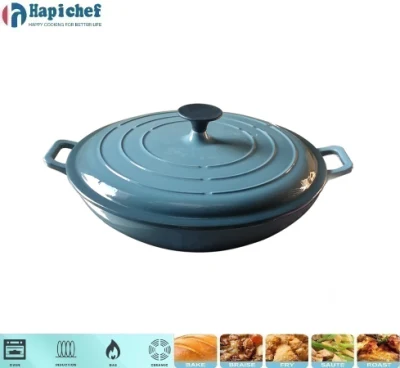grinding cast iron pan factory
The Art of Grinding Cast Iron Pans A Journey through Tradition and Craftsmanship
Cast iron frying pans have been a staple in kitchens for centuries, celebrated for their durability, heat retention, and excellent cooking properties. The process of creating these beloved kitchen tools is an intricate blend of art, science, and tradition, particularly in the grinding stage of production, which ensures the quality and performance of each pan.
Understanding the Basics of Cast Iron
Cast iron is an iron-carbon alloy known for its exceptional durability and retention of heat. When molded into a pan, cast iron can withstand high temperatures, making it ideal for frying, baking, and even grilling. However, the quality of the finished product heavily relies on the precision and care taken during its manufacturing process, particularly during the grinding phase.
The Importance of Grinding
Grinding cast iron pans involves removing rough edges and imperfections from the surface of the cast piece. This stage is crucial for several reasons
1. Surface Smoothness A smooth surface enhances the cooking experience by ensuring that food does not stick to the pan. Ground pans are easier to clean and maintain, which is vital for longevity.
2. Even Cooking Grinding ensures that the surface of the pan is uniform, which promotes even heat distribution. Uneven surfaces can lead to hot spots, causing food to cook inconsistently.
3. Aesthetic Appeal Beyond functionality, a well-ground cast iron pan looks more appealing. Consumers often consider aesthetics when purchasing kitchenware, and a polished finish can significantly influence their decision.
4. Coating Preparation For those pans that require seasoning or an enamel coating, grinding provides the necessary surface texture for optimal adhesion, further enhancing the pan’s cooking properties.
The Grinding Process
grinding cast iron pan factory

The grinding process typically involves several steps carried out by skilled artisans in specialized factories. Here’s how it usually unfolds
1. Initial Shaping After casting, the pans take their rough form but will contain casting imperfections such as burrs and excess material.
2. First Grind The pans are sent to a grinding machine where coarse abrasives remove the majority of these imperfections. This step focuses on achieving a general uniformity in shape.
3. Fine Grinding A second round of grinding uses finer abrasives, which polishes the surface and removes any lingering roughness. This step is vital for achieving that smooth, non-stick surface that users expect from quality cast iron cookware.
4. Quality Control Post-grinding, each pan is inspected to ensure it meets stringent quality standards. This includes checking for any missed imperfections or inconsistencies in the grinding process.
Craftsmanship and Tradition
The grinding of cast iron pans is not merely a mechanical process; it is deeply rooted in craftsmanship. Many factories pride themselves on their traditional techniques, passed down through generations. Artisans often use a combination of modern technology and time-honored practices, resulting in pans that not only perform well but also carry the legacy of expert craftsmanship.
Furthermore, the emphasis on sustainability in modern production means that many manufacturers are sourcing their materials responsibly and focusing on creating durable products that will last for generations. This environmental consciousness resonates with consumers, who increasingly value ethical and sustainable purchasing options.
Conclusion
Grinding cast iron pans is an essential step in the manufacturing process, one that determines the quality and performance of these much-loved kitchen tools. From ensuring even cooking to enhancing aesthetic appeal, the grinding process reflects a commitment to craftsmanship and tradition that has stood the test of time. As consumers continue to appreciate the value of high-quality cookware, the factories that produce these cast iron pans remain at the forefront of a culinary renaissance, ensuring that each pan is not just a tool, but a piece of history ready to be passed down through the ages.
-
Why Every Kitchen Needs a Casserole Cast Iron DishNewsJun.24,2025
-
Experience the Tradition and Quality of Cast Iron CookwareNewsJun.24,2025
-
Double Sided Cast Iron Grill PanNewsJun.24,2025
-
Cast Iron Dutch Ovens You’ll Actually UseNewsJun.24,2025
-
Buy Cast Iron Griddle for Everyday CookingNewsJun.24,2025
-
Barbecue Iron Grill Cooking PowerNewsJun.24,2025
-
Standard Product Lines from Cast Iron Cookware SuppliersNewsJun.11,2025
